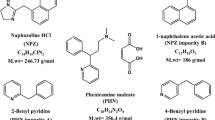Abstract
A novel, simple, precise, specific, accurate high-performance thin-layer chromatography (HPTLC) method was developed and validated for the estimation of bromfenac in ophthalmic solution. Diclofenac sodium was used as an internal standard (IS) because of its structural resemblance with bromfenac to develop a more accurate and precise method. Silica gel 60 F254 HPTLC plates were used to separate bromfenac from the formulation with a mobile phase consisting of toluene-ethyl acetate-glacial acetic acid (65:35:0.2, V/V). Densitometric scanning was performed at 274 nm after the HPTLC plates were air-dried. Well-resolved bands and good peak shapes were obtained for both bromfenac and diclofenac sodium, with retention factor (RF) values of 0.28 and 0.44, respectively. The proposed method was validated as per International Council for Harmonisation Q2 (R1) guidelines for specificity, precision, robustness, accuracy, and recovery. The drug shows linearity in the concentration range of 60‒270 ng/band and the correlation coefficient was found to be 0.999. The mean percent recovery of bromfenac was found to be 100.7%. The limit of detection and limit of quantification values for bromfenac were found to be 7.4 ng/band and 22.5 ng/band, respectively. The method was found to be novel since no HPTLC methods have yet been reported for the estimation of bromfenac. The developed method was successfully applied for the quantitative analysis of the drug in the ophthalmic formulation.






Similar content being viewed by others
References
Rajesh KR, Bryan R, Sachin DR, Khoa H (2014) Bromfenac ophthalmic solution for treatment of postoperative ocular pain and inflammation: safety, efficacy, and patient adherence. Patient Prefer Adherence 8:925–931. https://doi.org/10.2147/PPA.S46667
National Library of Medicine (US), National Center for Biotechnology Information (2022) Pubchem compound summary for CID 60726, Bromfenac. https://pubchem.ncbi.nlm.nih.gov/compound/Bromfenac. Accessed 8 Aug 2022
Zhai MZ, Wu HH, Li JJ (2015) Topical bromfenac for post- cataract extraction. A systematic review and pooled analysis. Eur J Inflamm 13:130–135. https://doi.org/10.1177/2F1721727X15601732
John P, Cunha D (2021) Bromday Rxlist. https://www.rxlist.com/bromday-drug.html. Accessed 8 Aug 2022
Haritha RN, Saamidha T, Sushma E, Vivek SP, Sudheer KD, Sreekanth G (2013) Simple RP-HPLC method development and validation for simultaneous estimation of moxifloxacin hydrochloride and bromfenac sodium in eye drop. Int J Pharm Sci 5:689–698. https://doi.org/10.1093/chromsci/bmw089
Vishnuvardhana RG, Srinivasa RV, Ramakrishna K (2016) Experimental design based development of a liquid chromatographic method for the qualification and validation of related substances in bromfenac sodium in bulk drugs. J Chem Pharm Res 8:695–705
Vidya K, Uma MR, Vattikuti AA (2014) Method development and validation of RP-HPLC analysis of bromfenac in rabbit plasma. Int J Pharm Res Anal 4:440–443
Badithala SK, Sundararajan R (2018) A novel analytical method development and validation for the estimation of bromfenac sodium by using reverse phase- HPLC. Pharm Int J 7:569–573
Srinivasrao K, Ranga VR, JayaShree A (2016) Development and validation of a new stability indicating RP-UPLC method for the quantitative determination of bromfenac sodium and its impurities in an ophthalmic dosage form. J Chromatogr Sci 54:1514–1521. https://doi.org/10.1093/chromsci/bmw089
International Conference on Harmonization of Technical Requirements for Registration of Pharmaceuticals for Human use (2005) https://database.ich.org/sites/default/files/Q2%28R1%20Guideline.pdf. Accessed 8 Aug 2021
Acknowledgements
The authors are thankful to the management of Oriental College of Pharmacy and Central Drugs Testing Laboratory, Mumbai, for the support and guidance to carry out this research work.
Author information
Authors and Affiliations
Corresponding author
Ethics declarations
Conflict of interest
The authors declare no conflict of interest, financial or otherwise.
Rights and permissions
Springer Nature or its licensor (e.g. a society or other partner) holds exclusive rights to this article under a publishing agreement with the author(s) or other rightsholder(s); author self-archiving of the accepted manuscript version of this article is solely governed by the terms of such publishing agreement and applicable law.
About this article
Cite this article
Thomas, M., Jain, V., Sonawane, B. et al. Development and validation of a high-performance thin-layer chromatography method for the estimation of bromfenac in ophthalmic solution. JPC-J Planar Chromat 35, 627–633 (2022). https://doi.org/10.1007/s00764-022-00213-0
Received:
Accepted:
Published:
Issue Date:
DOI: https://doi.org/10.1007/s00764-022-00213-0



